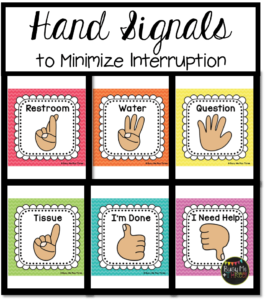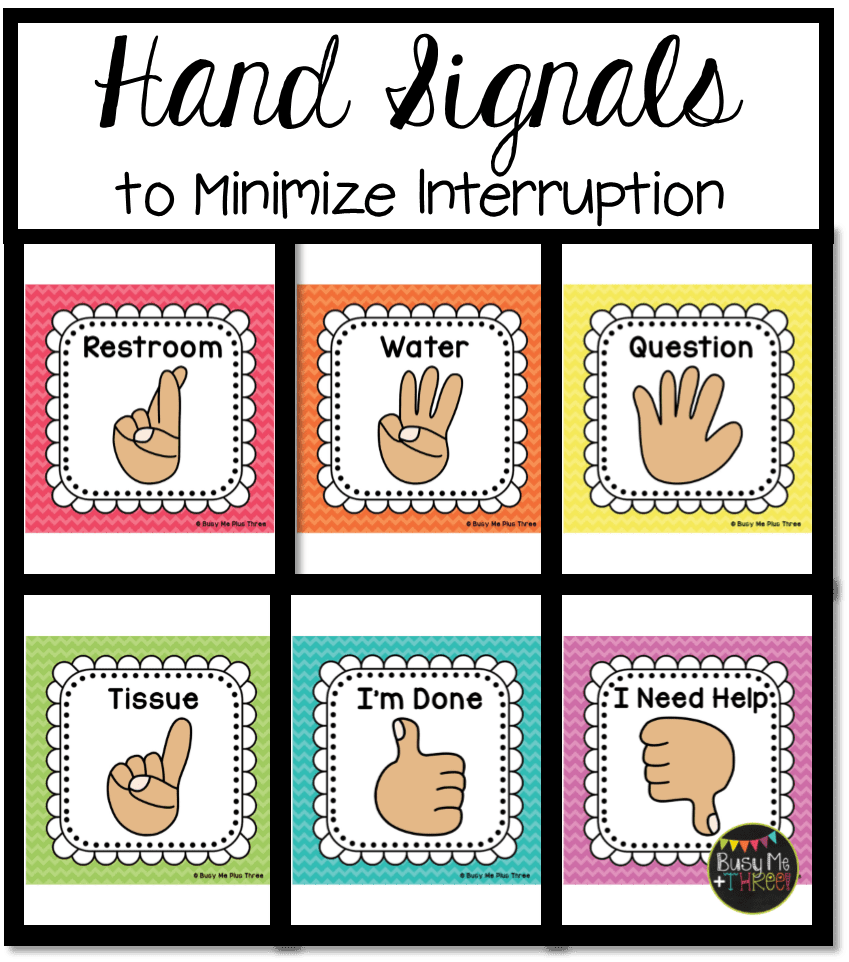Student Contributor: B. Musser
 Silent signals are a few predetermined hand signals/sign language symbols that students are able to use to ask permission from the teacher for simple tasks such as going to the bathroom or getting a drink. This procedure helps to prevent distraction in the classroom and allows for daily tasks to be carried out more smoothly.
Silent signals are a few predetermined hand signals/sign language symbols that students are able to use to ask permission from the teacher for simple tasks such as going to the bathroom or getting a drink. This procedure helps to prevent distraction in the classroom and allows for daily tasks to be carried out more smoothly.
This is a procedure that is used in place of having raised hands and prevents questions from being blurted out all day towards the teacher. Instead of having to pause the lesson over and over, and distracting the whole class, students just use silent and simple symbols to ask to use the bathroom, sharpen a pencil, get a drink, etc., and the teacher responds with a simple head nod of yes or no, or another simple symbol. These symbols need to be well explained and established right at the beginning of the year and carried out consistently throughout the year, so that there is no confusion and the procedure can be effective.
 This tool falls under the preventative phase, because it prevents classroom distraction and disruption. Most teachers are constantly interrupted during their lessons to answer menial questions, when a simple procedure such as this, can prevent any deviation from the lesson from happening. This procedure also relates to the supportive phase, because it supports better learning in the classroom, due to there being less distractions. This procedure falls best under the student-directed/collaborative theories because it promotes student responsibility and self-control, yet it is a joint effort between the student and the teacher. This procedure promotes responsibility and self-control, because the students must remember the symbols, how they are to be used, and to not take advantage of them, because they are a tool to be used correctly in order to be effective.
This tool falls under the preventative phase, because it prevents classroom distraction and disruption. Most teachers are constantly interrupted during their lessons to answer menial questions, when a simple procedure such as this, can prevent any deviation from the lesson from happening. This procedure also relates to the supportive phase, because it supports better learning in the classroom, due to there being less distractions. This procedure falls best under the student-directed/collaborative theories because it promotes student responsibility and self-control, yet it is a joint effort between the student and the teacher. This procedure promotes responsibility and self-control, because the students must remember the symbols, how they are to be used, and to not take advantage of them, because they are a tool to be used correctly in order to be effective.
More Information –
Tool Source: Pinterest
https://www.teacherspayteachers.com/Product/Hand-Signal-Classroom-Pack-831431



I tried this testing tool in a 4th-grade classroom of 21 students in a rural area. Silent hand signals for various tasks were introduced at the beginning of the year and have helped minimize many distractions to provide the most time for instruction. Our students use a signal for needing to use the restroom or getting water and we have a few signals that mean “yes” or “no please wait”. This prevents many disruptions that could distract and interrupt instructional time. All of the students use it and allow the students to practice making responsible and respectful decisions that don’t interrupt. We also added a few hand signals that mean “please stop talking” that we have used while teaching that has benefitted the class as a whole greatly. This tool is definitely one I want to use and implement in my own classroom because I have seen how helpful for the students and teachers it is.
I tried testing this tool in a Kindergarten classroom with 21 students in a suburban area. This tool was fairly simple to prepare for and use in the classroom. At the beginning of the school year as a class, we practiced the signal for “bathroom” and “water”. It did take a couple of days for students to be able to remember what the signals were, but once students did this tool was very successful. Students can ask if they can get a drink of water or use the restroom without blurting out or raising their hands and talking. My mentor teacher and I both simply look at the student and nod our heads yes to give the student permission, without needing to stop/interrupt the lesson we are teaching. Using this tool in kindergarten does require frequent reminders to students about the expectations for using the signals. It involves intentional effort when students raise their hands and ask, “Can I use the bathroom” or “Can I get a drink of water,” ensuring students consistently show the sign before seeking permission, thereby reinforcing the correct way to ask for approval.